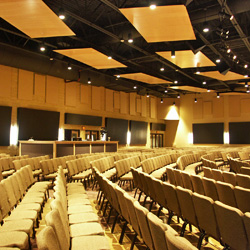Acoustics is arguably the single most important consideration for new and existing houses of worship.
In order to effectively communicate the message through spoken word or music, a good acoustical environment is critical.
Poor speech intelligibility or inadequate music reproduction can make it difficult for members of your congregation to receive and understand the message as it was intended to be heard.
Acoustics is a comfort factor. The acoustics of your space should be as important as, or even more important than, the lighting, heating, cooling, seat cushions, or any other design factor that affects comfort.
Oftentimes, the sound system is blamed for a poor sounding sanctuary. One might think that things will be improved by purchasing a bigger and/or newer sound system if they are not happy with the sound quality of their room.
This is rarely the case. The equipment in your sanctuary will only be as good as the acoustic environment in which it is placed. You must address the acoustical properties of the room itself in order to solve the root of the problem.
There are some common acoustical problems that many houses of worship face. It is important to be aware of these problems and to understand how they can be avoided or remedied in your sanctuary.
Sound Isolation and Noise
Isolation can be defined as keeping outside sounds out and inside sounds in. Sound from the outside – such as from nearby roads, airports or train tracks – must be kept outside.
If the house of worship is located in a residential neighborhood, you might also wish to keep your noise – from the service itself or from outdoor building equipment – from bothering the community.
Sources of noise include air conditioning, fans, lighting, highway traffic, air traffic, trains and footfall noise. Sound travels like water.
Any little leak in the system and sound will find a way to escape. Typically, a construction approach is needed in order to add mass to the existing structure to isolate it.
Noise is best controlled by using sound transmission (sometimes called “soundproofing”) products during the construction phase. There are fairly common building materials that can isolate the room without adding a lot to the cost of construction.
For example, simply doubling up on drywall on both sides of a wall or insulating interior walls can help with sound transmission issues. Sound isolation can be a tricky subject and acoustical professionals should be involved to determine the best course of action.




















